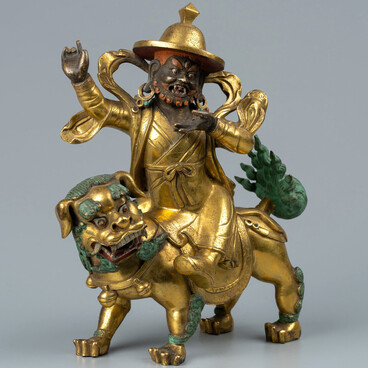The Samara Regional Art Museum presents a small table screen — a magnificent example of Japanese decorative and applied art. In some cases, such screens could also be used to protect a candle flame from the wind. In the foreground of the front side, the screen is richly decorated with images of flowers, roosters and chickens made with mother-of-pearl inlay set against the background of a landscape. On the reverse side one can see a very traditional and streamlined image of butterflies, birds, and flowers. Both landscapes are distinguished by the elegance, refinement, and succinctness which are characteristic of Japanese art.
Various techniques were used to make the exhibit. Those includes maki-e and raden. Maki-e, or sprinkled picture, is a technique of Japanese decorative art, in which an image is drawn with lacquer on the surface of the item, after which gold powder is sprinkled on the lacquer which has not yet fully dried. When it dries, a sparkling pattern remains, which is then refined by repeated polishing.
Raden is one of the traditional decorative Japanese techniques used for lacquerware, in which linings of mother-of-pearl are inserted into the surface of the item. The word “raden” is made up of “ra” — “shell” and “den” — “insert”. In Japan, this term is used to describe either the mother-of-pearl inlay technique itself, or the products made in it.
Mother-of-pearl was brought to Japan from China during the Nara period (710 — 794). One of the oldest mother-of-pearl inlaid items that have survived to this day is kept in the treasury of the Shōsō-in temple of Todai-ji (the city of Nara) — a musical instrument biwa. The raden technique developed rapidly during the Heian period (794 — 1185) and was used not only in decorative and applied arts, but also in architecture. With the advent of the Edo period (1603 — 1867), the ancient technique began to be used for the manufacture of products influenced by the European style (namban art): dressers, revetments for icons, and coffee cups. There was a rapid growth of pearl hunting due to the development of trade with the West.
Layers of shells of freshwater pearl oysters, anodons, zebra mussels, sea mussels, oysters and curled cephalopods, such as the nautilus, are used to get mother-of-pearl. There are many techniques for making raden products: atsugai-hō is the use of thick pieces of shell, the usugai technique uses thinner pieces, and kenma is used for the thinnest layer of mother-of-pearl. The methods of combining the materials may vary: thicker mother-of-pearl pieces can be embedded into a pre-cut shape, thin mother-of-pearl can be pressed into a thick layer of lacquer or glued and varnished on top.
Various techniques were used to make the exhibit. Those includes maki-e and raden. Maki-e, or sprinkled picture, is a technique of Japanese decorative art, in which an image is drawn with lacquer on the surface of the item, after which gold powder is sprinkled on the lacquer which has not yet fully dried. When it dries, a sparkling pattern remains, which is then refined by repeated polishing.
Raden is one of the traditional decorative Japanese techniques used for lacquerware, in which linings of mother-of-pearl are inserted into the surface of the item. The word “raden” is made up of “ra” — “shell” and “den” — “insert”. In Japan, this term is used to describe either the mother-of-pearl inlay technique itself, or the products made in it.
Mother-of-pearl was brought to Japan from China during the Nara period (710 — 794). One of the oldest mother-of-pearl inlaid items that have survived to this day is kept in the treasury of the Shōsō-in temple of Todai-ji (the city of Nara) — a musical instrument biwa. The raden technique developed rapidly during the Heian period (794 — 1185) and was used not only in decorative and applied arts, but also in architecture. With the advent of the Edo period (1603 — 1867), the ancient technique began to be used for the manufacture of products influenced by the European style (namban art): dressers, revetments for icons, and coffee cups. There was a rapid growth of pearl hunting due to the development of trade with the West.
Layers of shells of freshwater pearl oysters, anodons, zebra mussels, sea mussels, oysters and curled cephalopods, such as the nautilus, are used to get mother-of-pearl. There are many techniques for making raden products: atsugai-hō is the use of thick pieces of shell, the usugai technique uses thinner pieces, and kenma is used for the thinnest layer of mother-of-pearl. The methods of combining the materials may vary: thicker mother-of-pearl pieces can be embedded into a pre-cut shape, thin mother-of-pearl can be pressed into a thick layer of lacquer or glued and varnished on top.





